10 Best Dumbbell Exercises for Back Domination
Dumbbells are a versatile and effective piece of equipment for anyone looking to train their back muscles. Whether you are a beginner or an advanced athlete, incorporating dumbbell exercises into your back workout routine can help you build a stronger and more defined back.
Not only do dumbbell exercises provide a great range of motion, but they also challenge your stabilizer muscles and engage your core.
In this article, I will highlight the best dumbbell exercises to train your back. I will cover a range of exercises that target the major muscle groups in your back, including the latissimus dorsi, trapezius, rhomboids, and erector spinae.
From rows to pullovers, I will explain the proper technique for each exercise and discuss their benefits. Whether your goal is to improve your posture, increase your strength, or enhance your athletic performance, these dumbbell exercises will help you achieve your goals.
Dumbbell One Arm Row
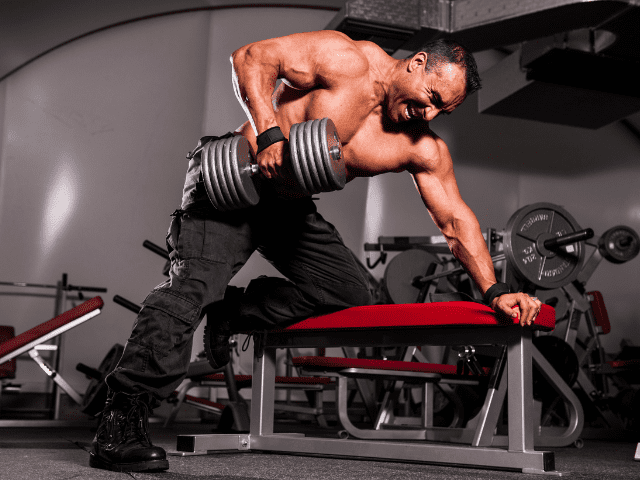
Probably the most popular, and most effective, dumbbell exercise for the back is the Dumbbell One Arm Row.
One Arm Rows allow you brace yourself with your off-hand and row some pretty heavy weight.
If developing strength is the goal, this movement should be a staple in your programming, especially if you’re primarily (or exclusively) using dumbbells.
Step-by-Step Instructions
- Grab a dumbbell and a bench*.
- Place the dumbbell next to the bench and set yourself up.
- If rowing with the right arm, place the left knee and left hand on the bench. Keep the right foot flat on the ground.
- Make sure the back is flat (neutral) to slightly arched.
- Brace the core and pick the dumbbell up.
- Row the dumbbell up, keeping the elbow close to the body as the dumbbell raises.
- Squeeze the back at the top of the rep and then lower the dumbbell down until the arm is fully extended.
- Repeat for the designated number of reps and then switch sides.
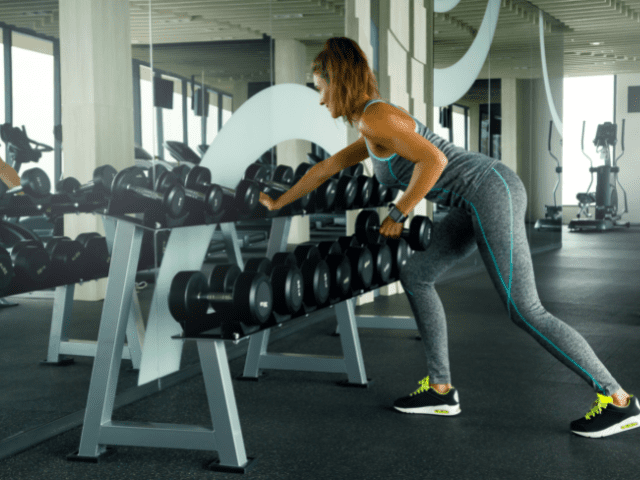
*One Arm Rows do not have to be done with one knee on a bench. You can keep both feet flat on the ground and lean forward and brace yourself with your off-hand on something sturdy. You can even lean your off forearm on your leg for support if necessary.
Coaching Points
The most common mistake I see athletes make when doing One Arm Rows is not maintaining a flat back. The back should stay engaged and slightly arched – similar to the starting position of a Power Clean. Do not let the back round as this can cause unnecessary stress on the spine.
Also, do not twist and turn while rowing. You’re not starting a lawn mower. If you need to use your whole body to twist and rock the weight up then the dumbbell is too heavy. Lower the weight and maintain proper form.
Finally, make sure to give yourself enough room to ‘spread out’ and get into a good position.
Often times I see athletes place their off-hand too close to their knee on the bench and/or place their grounded foot too close to the bench. This leads to them being too cramped, making it difficult to achieve proper positioning.
Renegade Rows
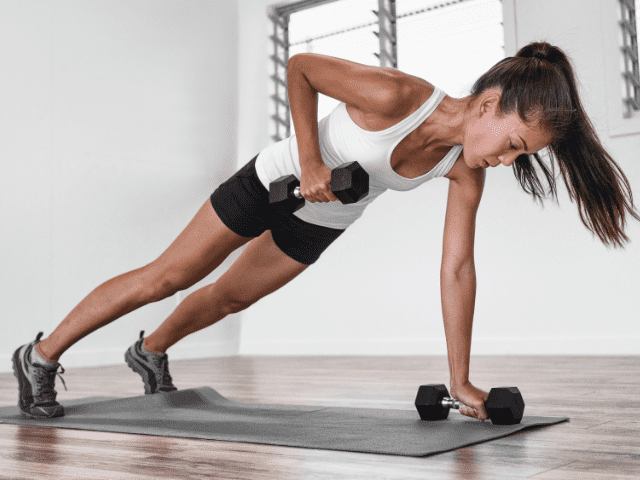
Renegade Rows are more than just a back exercise – they’re practically a total body movement.
Renegade Rows are done from a plank position and will heavily challenge your core, along with your shoulder stability, back and biceps.
They can be extremely challenging and one are one of those ‘love to hate’ kind of exercises.
Instructions
- Grab one dumbbell in each hand and assume a pushup position with feet about shoulder width apart.
- Make sure the core is braced and row one dumbbell up.
- Lower the dumbbell under control and return to the starting pushup position.
- Alternate rowing each arm until all reps are completed.
Coaching Points
Try to limit rotating the torso as much as possible. It’s natural to want to open the torso toward the side of the arm you’re rowing with – try to fight against this and stay as square as possible.
The wider your feet, the easier it is to stay balanced while you perform the movement. Try to keep feet about shoulder-width apart.
Dumbbell Hang Clean
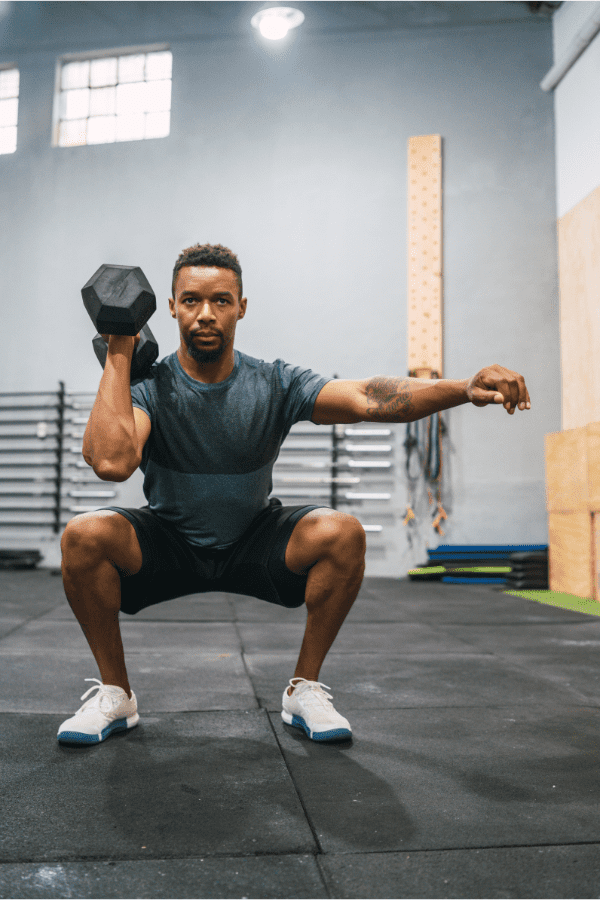
The Dumbbell Hang Clean may not be your “typical” back exercise, but make no mistake – Dumbbell Hang Cleans are great for back development.
The lower back (erector spinae) is emphasized on the hinge and the drive and the upper back becomes one of the primary focuses during the final pull of the clean.
Pro Tip: Dumbbell Hang Cleans can be done with two dumbbells at the same time (as described below) or one arm at a time (as in the pic above).
Instructions
- With a flat back, stand tall with the dumbbells.
- Eyes should be focused straight ahead, and weight distributed between the heel and midfoot.
- Curl the wrists by turning the knuckles down towards the floor.
- Set the back by squeezing the shoulder blades together (“chest out”) and engaging the lats.
- Deep breathe in and brace the core.
- Put a slight bend in the knee and then hinge forward by pushing the hips back and allowing the dumbbells to slide down the thigh. Shoulders should end up above, or slightly in front of, the dumbbells.
- Once the dumbbells reach a few inches from the knee – you are now in the proper hang position for the DB Hang Power Clean.
- From here, drive the floor with the feet and explosively extend the hips forward.
- Finish the drive by triple extending through the hips, knees and ankles. This full extension should be immediately followed by an aggressive shoulders shrug.
- Now, pull the elbows high while keeping the dumbbells close to the body.
- Transition to the catch (front rack position) by quickly shifting the feet from hip width to shoulder width and dropping the hips down into a partial squat. The elbows should quickly swing down and under, staying close to the body and finishing with the elbows high and triceps parallel to the floor.
- The ends of the dumbbells should land on the shoulders with palms facing each other.
- Make sure you are braced to receive the dumbbells in the catch position and then return to a standing position.
Coaching Points
Make sure to maintain a neutral, flat back during the hinge. One of the biggest mistakes that can lead to an injury is allowing the back to round during the hinge. This puts an excessive amount of strain on the spine as the athlete begins the movement.
If the athlete cannot maintain a flat back, lower the weight and incorporate more exercises that can improve the upper back strength needed to maintain a proper position like RDLs.
The dreaded rounded back can also occur if the lifter hinges too aggressively and quickly extend without maintaining a braced core. I usually see this when athletes are trying to ‘rock’ into the pull instead of getting properly set.
If the athlete is striking the dumbbells on the thighs as they reach the hip crease, then they must make sure that the dumbbells don’t swing out away from them. The dumbbells should stay close to the body throughout the entire second pull.
Dumbbell Upright Row

The Dumbbell Upright Row is both a great dumbbell back exercises as well as a great dumbbell shoulder exercise.
Many lifters actually prefer dumbbells over a barbell for Upright Rows because it’s more comfortable on the wrists and even the shoulders. This is because the lifter has more control over the range of motion and the angles of the dumbbells throughout the movement.
Step-by-Step Instructions
- Grab two dumbbells and start with them at arm’s length in front of the thighs, palms toward the body.
- Flex knees slightly and stand upright with good posture.
- Pull the dumbbells upward along the abdomen and chest toward the chin.
- At the top, the elbow should be higher than the wrist, and above the shoulders.
- Lower the bar dumbbells and under control to the front of the thighs.
- Do not ‘jerk’ or ‘rock’ the weight up and keep the dumbbells close to the torso thoughout.
Coaching Points
The biggest mistake I see, by far, with Dumbbell Upright Rows is swinging way too much to lift the weight.
A little swing is okay if you’re trying to grind out the last rep or two of a set, however, if you’re having to rock your torso for every rep then the weight is too heavy. Grab some lighter dumbbells and use proper form.
Dumbbell Shrugs
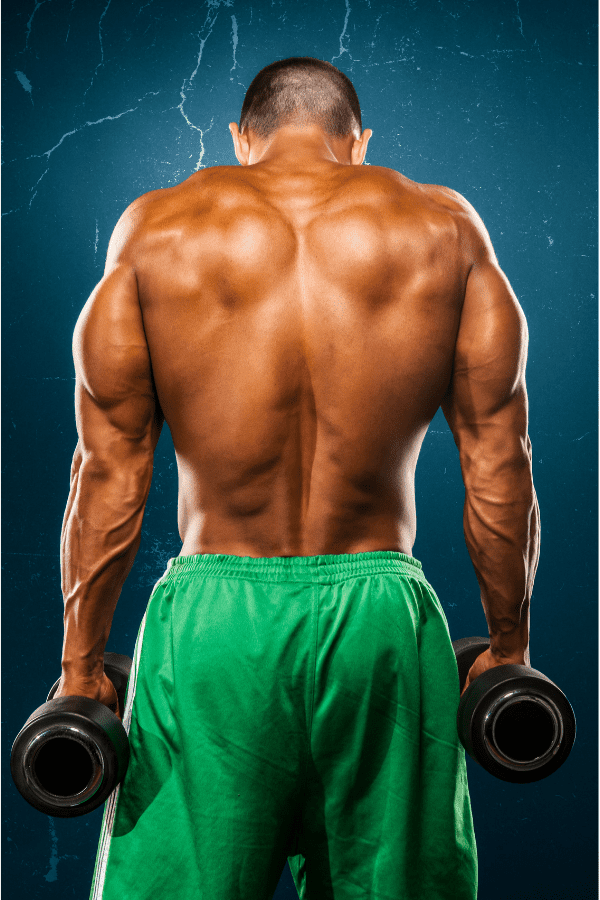
If you’re wanting a dumbbell exercise to focus on the upper traps, then you can’t do much better than Dumbbell Shrugs.
Step-by-Step Instructions
- Grab a pair of dumbells, one in each hand
- Place feet hip-width apart, brace the core and stand tall
- Now shrug up, visualizing touching your traps to your ears.
- Do NOT ‘roll’ the shoulders. Shrug straight up and straight down.
- Keep good posture. Do not let the shoulders slouch forward during the set.
- Control the weight back down to the starting position and repeat.
Coaching Points
Shrugs already have a short range of motion. Don’t shorten the range of motion even further by grabbing more weight than you can properly lift. (A mistake I see quite often)
When using heavy weight, I highly suggest using a hook grip on the dumbbells to help maintain grip.
Finding a box or bench to rest the dumbbells on in between sets can be a gamechanger as opposed to lifting them off the ground each set.
Dumbbell RDL
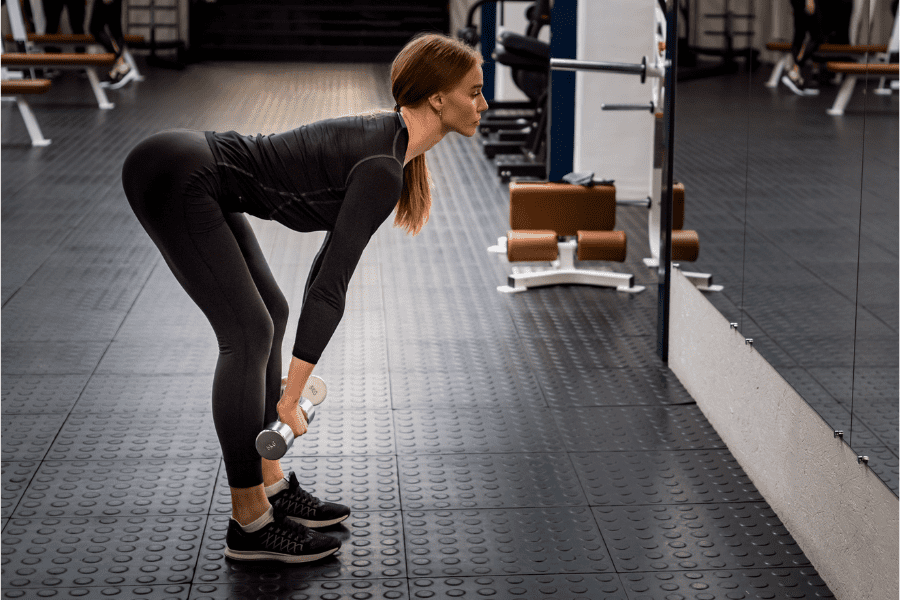
The Dumbbell RDL works the back a bit differently than most of the other exercises on this list.
DB RDLs work the back more isometrically – basically the back has to stay engaged to maintain the posture of the lift. This is much different than a row for example, but its still extremely effective.
Dumbbell Romanian Deadlifts also work the entire back, from the erector spinae muscles all the way up to the trapezius and rhomboids.
Step-by-Step Instruction
- With the two dumbbells or kettlebells at your feet, you should hinge at the waist and bend at the knee, keeping a nice flat back, and lift the dumbbells off the ground.
- Standing nice and tall, squeeze the shoulder blades back and create tension in the abdomen.
- Keeping a neutral spine, fixing the eyes forward (DO NOT CRANE THE NECK BACK).
- Initiate the movement by pushing the hips back, hinging at the waist, and keeping a slight bend in the knee.
- The eccentric movement will continue until the dumbbells are about 3/4 down your shins.
- Once the dumbbells are about 3/4 of the way down your shins, start to extend the hips, keeping tension in the abdomen and keeping the upper back nice and tight, straightening the knees until you return to standing in the starting position.
Coaching Points
It is important for the lifter to maintain a neutral spine, maintaining tension in the abdomen and upper back. Remember to breathe in and hold the breath during eccentric (lowering the weight) and breathe out as you perform the concentric movement (bringing the weight back up).
Chest Supported Dumbbell Row
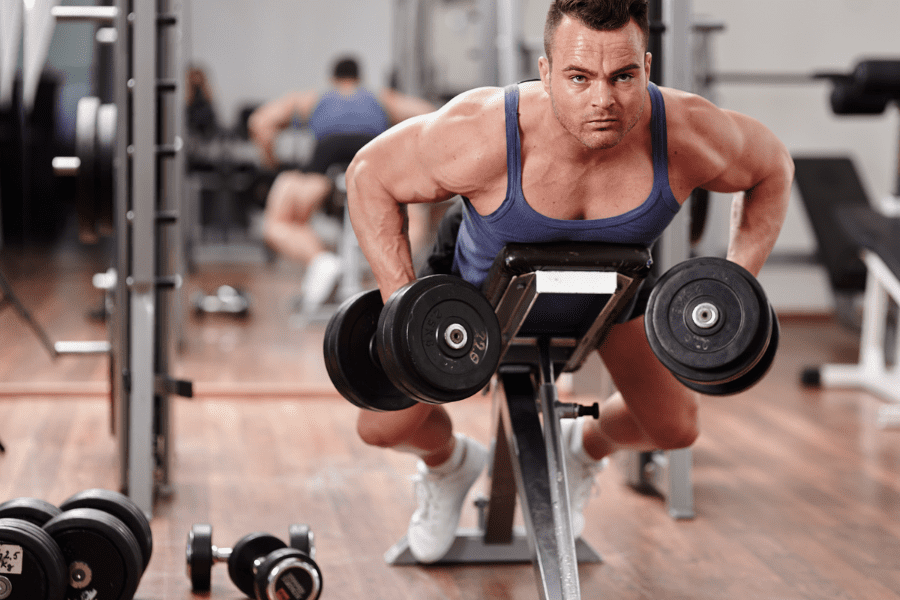
Chest Supported Dumbbell Rows utilize an incline bench to support the torso while rowing with both arms.
If you only have dumbbells to work with they can be an excellent alternative for T-Bar Rows – a machine that functions the same way, but it too bulky and expensive for most home gym owners.
How To
- Set up an adjustable bench at a 45-degree angle.
- Lay on your stomach with your head hanging just above the edge of the bench.
- Grab a dumbbell in each hand and set up with a good posture – core and lats engaged and shoulders neutral.
- Row the dumbbells toward the top of the stomach and squeeze the back at the top of the rep.
- Finally, lower the dumbbells back to the starting position and repeat until all reps are completed.
Coaching Points
Make sure to maintain good posture through the movement. Oftentimes I see athletes who allow their shoulders to slouch forward and drape over the edges of the bench.
Rear Delt Raise
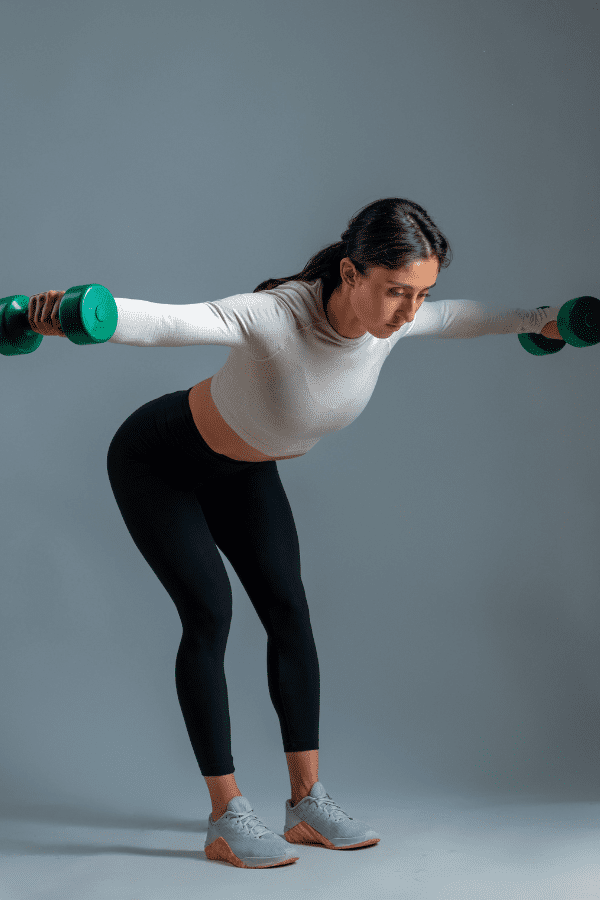
Rear Delt Raises may not be as effective at strength development as many of the options listed here, but they are really good at targeting the posterior delts, mid-traps, teres minor and rhomboid.
They can fit really well as part of a warm-up or toward the end of a workout for extra hypertrophy work.
Step-by-Step Instruction
- Grab your dumbbells (or plates) and bend at the waist until you are close to perpendicular to the floor.
- I recommend slightly bending the elbow and keeping your palms facing each other. As you execute the movement, the palms will face the floor.
- Initiate the movement by bringing your arms out to the side and squeezing the shoulder blades.
- Pause at the top of the movement for about 1 second.
- Slowly lower your arms back to the starting position.
Coaching Points
In the setup, be sure to bend at the waist enough so that you are perpendicular as much as possible. In this movement, the burn should be felt in the upper back and rear shoulders. If your setup is too vertical, you may feel the burn in the traps or medial delts.
Don’t hitch (bounce) into lockout. If you find yourself using your torso to hitch, go down in weight. The emphasis here is on time under tension and quality movement still matters.
Do not bang the dumbbells together at the bottom of the rep. Stay in control of the movement throughout.
Dumbbell Pullover
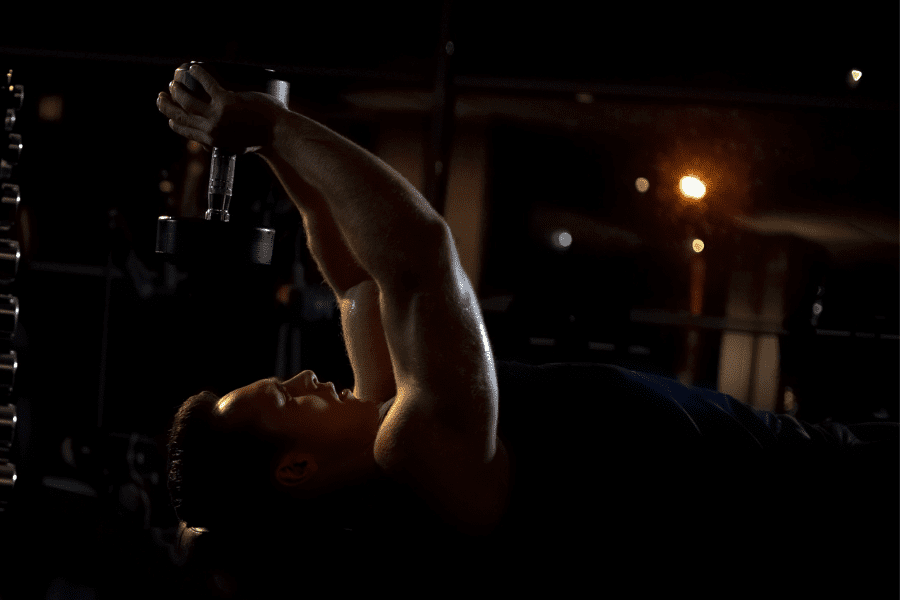
Dumbbell Pullovers are one of my favorite exercises for working the lats. In fact, they’re probably the best dumbbell exercise for targeting the latissimus dorsi.
They’re also great for hitting the serratus anterior, pecs and triceps.
Pullovers are really a sneaky effective compound exercise in an extraordinary simple looking lift.
How To
- Lay on a bench with the top of your head all the way to the edge of the bench.
- Make a diamond shape with your hands and place them on the inside of one of the heads of the dumbbell.
- Press the dumbbell to arm’s length straight up over the chest.
- Now, reach the dumbbell overhead (allow some bend in the elbow) until your hands are about even with the height of the bench.
- Finally, pull the dumbbell back to the starting position.
Coaching Points
This exercise will give a deep stretch to the chest and triceps on the lift’s eccentric (lowering) phase. Stay slow and controlled and focus on the stretch followed by the strong contraction as you raise the dumbbell back to the start.
Dumbbell Bent Over Row
Dumbbell Bent Over Row is the dumbbell version of the popular Bent Over Barbell Row.
All the same basic principles apply – the only real difference is that you use dumbbells instead of a barbell.
Similar to the Upright Row, some lifters prefer using dumbbell for Bent Rows because the dumbbells allow for a more customized range of motion and movement angles.
Step-by-Step Instruction
- Stand with your dumbells at your sides on the ground.
- Hinge at the waist and bend the knee until you can grab the dumbbells.
- Always keep a flat back, a neutral spine, and keep your eyes focused slightly down about 1 foot in front of you.
- Take a deep breath, brace the abdomen, and pull the dumbbells in until they are in line with your torso.
- Pause for about 1 second. Squeeze the shoulder blades and lock in the rep.
- Slowly return the dumbbells back to the starting position (dumbbells at about the knee).
Coaching Points
This is a great movement to develop posterior chain strength. It is also a great exercise in progression to Barbell Bent Over Rows.
The setup here is very similar to the Deadlift. With that in mind, always remember to keep a nice neutral spine. DO NOT ROUND YOUR BACK.
Another common mistake is I have seen lifters go too heavy and therefore need to “hitch or yank” into a lock-in position. Never sacrifice your form for more weight. You will get hurt eventually.

Get Shredded… For Free
Get a free workout Monday through Friday, posted right here on Horton Barbell. These workouts are designed to help you get strong, in shape and look great at the beach!
Final Thoughts
Dumbbells are extremely versatile pieces of equipment that have an almost infinite number of uses.
The exercises you can do with dumbbells to build and develop a strong back – or even specifically just for the traps.
So, whether you have a set of dumbbells or a pair of adjustable dumbbells, you have all you need to get in some great back workouts.
